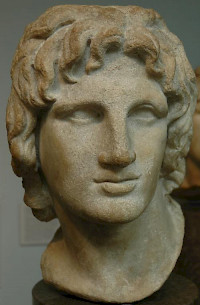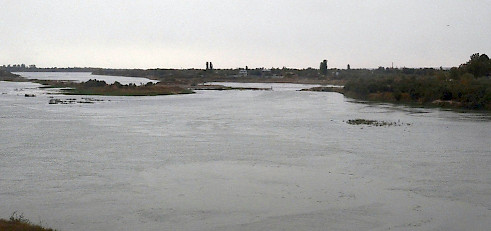Jaxartes (329 BCE)
Q123215Battle of the Jaxartes (August 329 BCE): battle between the Macedonian king Alexander the Great and an army of Central-Asian mounted nomads. It was arguably Alexander's most spectacular battle.
Prelude

The battle was forced upon Alexander. He had already decided to accept the river Jaxartes as the northeastern frontier of his empire, as it had been during the days of the Achaemenid Empire that he had overthrown. A new city, called Alexandria Eschatê, was to mark the frontier. While the Macedonians started construction on the new town (and perhaps because of this), the native Sogdians revolted. Since the days of Cyrus the Great (r.559-530) they had been left more or less to their ancestral way of life, and the construction of a city meant an intrusion by a different life style.
Alexander immediately retaliated against the rebels, and there was heavy fighting around the local native settlements. During one of the battles, the king was wounded in the throat. Yet the rebels were forced to surrender and the situation seemed to return to normality. However, news arrived that the Sogdian leader Spitamenes was besieging Maracanda in the south; at the same time, an army of mounted nomadic warriors appeared north of the Jaxartes, eager to join in the struggle and take away the loot. They are variously called Scythians or Sacae, two versions of the same name (Skudat, "archers"). If Alexander wanted to restore order in the south, he first had to beat the nomads in order to secure his rear.
The Macedonian king sent an officer named Pharnouches south to confront Spitamenes, and personally attacked the Sacae in what was to become a sensational fight. The Sacae had occupied the northern bank of the Jaxartes, confident that they could beat Alexander's men as they disembarked, but underestimating the harmony with which the Macedonian artillery, fleet, cavalry, and infantry would collaborate.
Battle

The Jaxartes is wider than a bowshot, which meant that the Macedonians could board their hurriedly prepared ships and rafts in safety, but that they would enter the Sacan field of fire halfway across the river. Alexander took two measures to prevent early defeat. In the first place, he ordered that the crossing would take place en masse, so that the mounted enemy archers would be faced with more targets than they could strike at; and he ordered his artillery to cover the soldiers in the ships. (Catapults have a greater range than bows.)
The artillery attack that opened the battle was successful. One of the Sacan leaders was immediately hit and killed and the other Sacae, understanding that the enemy catapults were more dangerous than their own bows, retired from the bank. For the Macedonians, it was now easy to cross the Jaxartes. Alexander's archers were the first to disembark, positioning themselves as a covering screen for the rest of the force; the cavalry followed, and the soldiers of the phalanx were the last ones to arrive.
The Macedonians had now created a beachhead and the Sacae should have retreated. Once contact had been broken off, their enemies would never have been able to pursue them across the steppe. Alexander, however, wanted to maintain contact and provoke a battle; therefore, he ordered a battalion of mounted spearmen to advance and invite an enemy attack.
The nomads did not recognize this sacrifice for what it was. In their society, in which blood feuds were normal, no commander would have sacrificed troops to obtain a better position for the main force. The families of those who had been killed would immediately start a vendetta. Alexander, on the other hand, could send his mounted spearmen on this dangerous mission because his men were professionals and understood that they were not really left alone. To them, it was a professional risk.
Alexander's mounted spearmen were immediately surrounded and attacked by the Sacan mounted archers. Once they were engaged, their position was fixed and they were vulnerable to an approach by the Macedonian infantry and the Cretan archers. Advancing on a broad front, Alexander's infantry and light troops closed in upon the nomads, who now found themselves caught between the Macedonian mounted spearmen and the rest of Alexander's army. The Sacae tried to escape to the wings of the Macedonian lines, but here they were met by Alexander's infantry.
This was the end of the battle. About 1200 Sacae were surrounded and killed, including their commander Satraces. About 150 of them surrendered. Their fellow tribesmen, seeing what had happened, decided to flee, and although the Macedonian king ordered the pursuit, the Sacae were able to reach safety, because Alexander, still suffering from his throat wound and now also suffering from dysentery, was unable to remain in the saddle for a long time.
Aftermath
It had been a splendid victory. About 1800 horses were captured. As far as the Macedonians and Greeks knew, no commander had ever been able to pin down and destroy a nomad army. With some justification, the Son of Zeus could claim to have succeeded where Cyrus and Darius I the Great had failed. This was a boost for Macedonian moral, and a psychological blow for the nomads north of the Jaxartes.
Alexander's main aim, however, had never been to subdue the nomads; he wanted to go to the south, where a far more serious crisis demanded his attention. He could do so now without loss of face; and in order to make the outcome acceptable to the Sacae, he released the prisoners of war without ransom. This policy was successful: the northern frontier of Alexander's empire was never seriously threatened again.
Most history books attribute four "big battles" to Alexander: Granicus, Issus, Gaugamela, and Hydaspes. From a tactical point of view, the Battle of the Jaxartes was certainly a more brilliant victory than any of these.